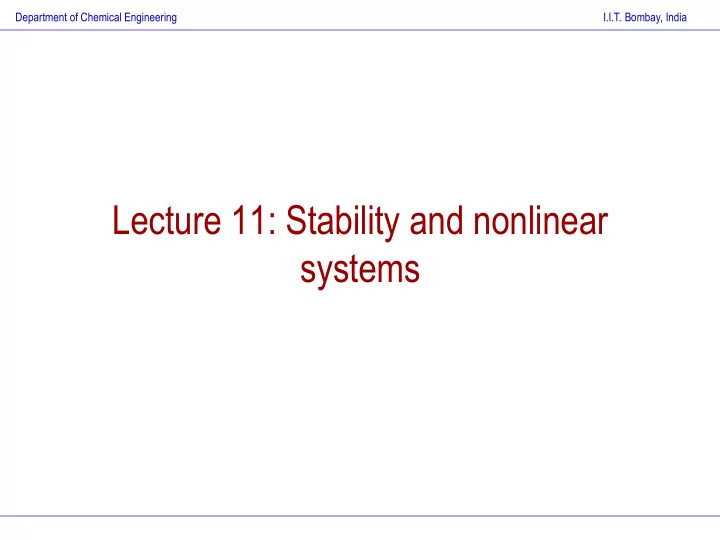

Department of Chemical Engineering I.I.T. Bombay, India Lecture 11: Stability and nonlinear systems
Department of Chemical Engineering I.I.T. Bombay, India Concept of system stability If the system is perturbed from its current (steady) state,does it do either of the following: Return to its original position Move to a new position in a “bounded” fashion Keeps on moving in a “bounded” fashion Keeps on moving in an “unbounded” fashion ?
Department of Chemical Engineering I.I.T. Bombay, India Illustrative examples A closed loop may exhibit any of the following behaviour: For a small perturbation in the set-point or a disturbance, the closed loop may respond in a variety of ways. Could the response be a function of the input size as well ?
Department of Chemical Engineering I.I.T. Bombay, India Illustrative examples (contd.) Consider the ramp response of a first order plant : Although the first order plant is “stable” for all other inputs, it exhibits “unbounded” behaviour due to input “unboundedness” Input dependence is even more true for nonlinear systems.
Department of Chemical Engineering I.I.T. Bombay, India Bounded Input Bounded Output stability For causal systems therefore, it makes sense to define stability in terms of bounded-ness to a bounded input. If in response to a bounded input the dynamic trajectory of a system remains bounded as t infinity, then the system is said to be stable; else it is said to be unstable. Definition takes care of ramp system responses as well as sustained oscillations seen in some closed loop systems.
Department of Chemical Engineering I.I.T. Bombay, India Stability of linear systems Consider the general representation of general high order plants: q q 1 q 2 b s b s b s b ... q q 1 q 2 0 g ( s ) p p 1 p 2 b s b s b s ... b p p 1 p 2 0 Or, ( s z )( s z )....( s z ) 1 2 q g ( s ) K ( s r )( s r )...( s r ) 1 2 p The roots determine the behaviour of the system as is evident from the following:
Department of Chemical Engineering I.I.T. Bombay, India Stability of linear systems 1 y ( s ) g ( s ) s Expanding by partial fractions, p A A 0 i y ( s ) s ( s r ) i 1 i Inverting in the time domain, p r t y t A A e ( ) i 0 i i 1 Thus, if r i is positive, the output grows with time else, it decays with time. Important Note: The stability is unaffected by the locations of the zeros. Zeros thus do not affect the system stability.
Department of Chemical Engineering I.I.T. Bombay, India Stability of linear systems Thus if all the poles of the system lie in the left half plane,then the system is stable. For nonlinear systems, one can analyze the stability properties of the linearized system. If it is stable, the nonlinear system could be stable in a local neighbourhood. If the linearized system is unstable, the nonlinear system would also be unstable. Open Loop unstable systems can be stabilized under feedback. Open Loop stable systems can exhibit unstable performance under feedback. Note: Controller Design is therefore very important.
Department of Chemical Engineering I.I.T. Bombay, India Stability evaluation for state space form It can be shown that the eigenvalues of the A matrix are negative reciprocals of the time constants. The output behaviour can be written in exactly the same manner: p t y ( t ) A A e i 0 i i 1 where the ’s are eigen values of the matrix A Thus, if all the eigenvalues of the system A have negative real parts, the system is said to be stable.
Department of Chemical Engineering I.I.T. Bombay, India Conditional Stability The transfer function is conditionally stable based on the values of K 6 K g ( s ) 3 2 s s s K 48 44 12 ( 1 6 ) So, K has to be chosen judiciously so that one gets stable behaviour.
Department of Chemical Engineering I.I.T. Bombay, India Lecture 12: Process Identification
Department of Chemical Engineering I.I.T. Bombay, India First principles Modeling Model generated has high fidelity and is fairly accurate under various scenarios. Gives greater fundamental understanding of the process dynamics. Need fairly accurate and complete knowledge of the process parameters. Not particularly useful for poorly understood process. Very time consuming to generate. Involves parameter estimation
Department of Chemical Engineering I.I.T. Bombay, India Alternate Approaches to Model Building Empirical model forms Data + apriori Purely data Heuristics based Knowledge based based
Recommend
More recommend